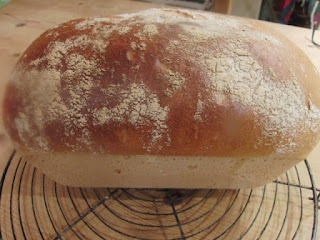I go in phases with bread. Making it, I mean, not eating it. It's easy enough to always have a sliced wholemeal loaf in the freezer, so that you're never without supplies but then I have a bread "moment" and before you can say Jack Robinson, the kitchen is filled with the smell of rising bread, and browning golden crusts are everywhere. For a start , once you've got the knack, it's so easy, just flour, water, and yeast, really, and a bit of salt. Unsalted bread is horrible. Elizabeth David said you should have plenty of salt in your bread, and none in your butter, personally I like a nice abit of salted Welsh butter as well.
And time, you do need some time, which is often the percieved problem with baking bread at home. It does take a few hours to make bread it's true, but you only spend a few minutes out of those hours actually doing anything. So really it comes down to organizing your bread making around your life, so that it fits in with everything else, and you only have to fiddle about with it when it suits you.
If you've never made bread before, or if you've tried once and got a "brick" and gave up, I recommend trying the New York Times No Knead Bread, which is fully described here. It's a slow, easy to do method which gives you a rustic, rather holey, but still delicious loaf, and well worth a look.
However, if you want to make a good slice-able white crusty loaf you could try my recipe
The Cottage Garden Farmer's White Crusty Loaf
When I want to make an ordinary white crusty loaf I use about half a 3lb/1.5kg bag of strong white flour. You can make any size you like as long as you remember that for each lb of flour you will need 1 teaspoon of fast acting dried yeast ( I use Dove's Farm) and 1 teaspoon of salt, and about half a pint of water. Nothing else, no oil, no sugar, no butter, unless you're making one of the endless variations which will be at your disposal once you've mastered the initial technique. It's one of those things that it's easier to show someone than to describe, but here's a few pictures to help.
Place your chosen amout of ingredients in a roomy, preferably wide bowl.
Make your hand into a "claw" like this
 and stir the dry ingredients round to mix in. Add the water and mix in using your claw hand until it comes together in a sticky mass. It will seem too wet, but persevere.
and stir the dry ingredients round to mix in. Add the water and mix in using your claw hand until it comes together in a sticky mass. It will seem too wet, but persevere.  Tip the lot out onto the floured work surface and knead for a few minutes. There is an accepted method of kneading bread involving pushing and pulling the dough in a rhythmic fashion, but frankly you can fling it about however you like as long as you stretch it enough to allow the gluten in the flour to develop and transform the sticky mass into
Tip the lot out onto the floured work surface and knead for a few minutes. There is an accepted method of kneading bread involving pushing and pulling the dough in a rhythmic fashion, but frankly you can fling it about however you like as long as you stretch it enough to allow the gluten in the flour to develop and transform the sticky mass intoPut it back in the bowl and leave, covered with cling film or a damp teatowel until doubled in volume.
Then turn it out on to your worktop again, and handling gently this time, fold in the edges to the centre a few times pressing gently down to get rid of big air bubbles, and place in a loaf tin. Dust with flour, or oatmeal. Leave until risen and puffy again,
and then bake in a very hot steamy oven (see below) for about 30 - 40 minutes. Turn out of the tin onto a wire rack to cool.
Tips for success
1.Make sure your yeast is fresh even if it's dried! I use Dove's Farm yeast and I keep it in the fridge after opening, and replace it within 6 weeks.
2. The half pint of water to one pound of flour is a minimum. Dry dough will mean dry bread.
3.Make the oven steamy. I throw half a cup of water into the bottom of the Aga just before I close the door, but if you're nervous about throwing water in your oven, try putting a few ice cubes in the bottom of the oven with your bread - they'll instantly melt and give you the steam you need to get your lovely crusty loaf.
4. If you can let your dough rise over a longer period, up to 24hours, you will get a fuller flavoured loaf, but you can adjust this to suit yourself. If you mix your dough in the evening aiming for next day bread, use cold waterin the mix and leave it in a cool place or even the fridge, for 24 hours or more until you're ready to bake it next day. But if you mix it say in the morning for bread for lunch, then you would use warm water, leave it in a warm place to rise, for an hour or two, you get the general idea.









































